Raytheon (Hughes) AGM-65 Maverick
The AGM-65 Maverick was the first general purpose fire-and-forget tactical air-to-ground missile in service with the U.S. Air Force. It was produced in very large numbers, and its later versions will remain in the U.S. inventory for some time in the future.
Development of the Maverick began in 1965, triggered by the bad performance of the AGM-12 Bullpup in South-East Asia. Rockwell and Hughes designed missiles for the ZAGM-65A Maverick requirement, and in 1968 Hughes was selected as prime contractor. The first unguided XAGM-65A prototype flew in September 1969, and in December that year the first guided launch resulted in a direct hit. In August 1972, the first production AGM-65A missiles were delivered to the USAF.
The AGM-65A is a relatively small missile powered by a Thiokol TX-481 (SR109-TC-1) dual-thrust solid-fueled rocket motor. It uses an electro-optical (TV) guidance system. The picture of a TV camera in the nose of the missile is displayed on a screen in the cockpit. When the pilot has selected a target, the TV image is "locked" in the missile's seeker logic, and the Maverick is fired. After launch, the AGM-65A homes on the target by constantly matching the TV camera image to the locked target image. The 57 kg (125 lb) WDU-20/B shaped-charge warhead is detonated by an impact fuze. The accuracy of the AGM-65A is reported as about 1.5 m (5 ft) CEP.
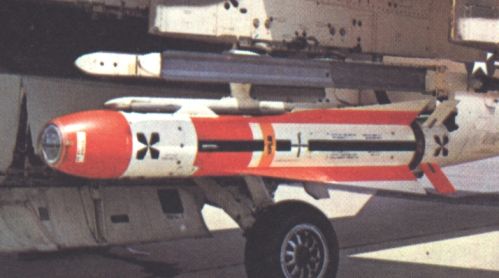 |
| Photo: Hughes |
| AGM-65A |
One drawback of the AGM-65A was the relatively small TV image presented to the pilot, requiring an unnecessarily close approach to the target. Therefore the AGM-65B was developed, which used scene-magnifying optics doubling the image resolution. This allowed the engagement of smaller or more distant targets. Development of the AGM-65B, a.k.a. "Scene-Magnification Maverick", began in 1975, and the missiles were delivered during the late 1970s. Production of the AGM-65A/B TV guided Mavericks ended in 1978 after more than 35000 missiles had been built.
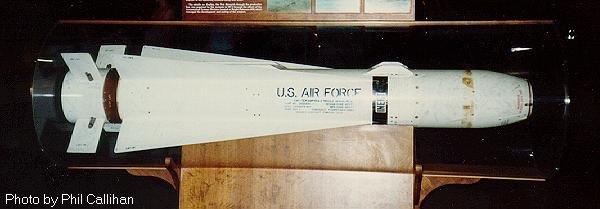 |
| Photo: Phil Callihan |
| AGM-65B |
The AGM-65C was to be a semi-active laser guided version for the U.S. Marine Corps. It was intended for close air support, and was equipped with a heavier 113 kg (250 lb) MK 19 blast-fragmentation warhead. Full-scale development began in 1978, but only a few AGM-65C missiles were built and the program was eventually cancelled because of high costs. The USMC's laser-guided Maverick requirement was later satisfied with the AGM-65E, q.v.
The AGM-65D "IIR Maverick" is a derivative of the AGM-65A and replaces the latter's TV guidance section with a WGU-10/B imaging infrared (IIR) seeker (the same seeker is also used in the GBU-15(V)2/B glide bomb and the AGM-84E SLAM). This seeker has almost twice the lock-on range of the AGM-65A, and allows effective use of the missile at night or in bad weather. Development of the AGM-65D began in 1977, and the first missiles were delivered to the USAF in October 1983, with IOC (Initial Operational Capability) achieved in February 1986. The AGM-65D was also the first variant to be produced with a new reduced-smoke Thiokol TX-633 (SR114-TC-1) motor (alternative motor was an Aerojet SR115-AJ-1) in the WPU-4/B propulsion section. The AGM-65D-2 is an upgraded version with a faster seeker for higher accuracy and moving target tracking.
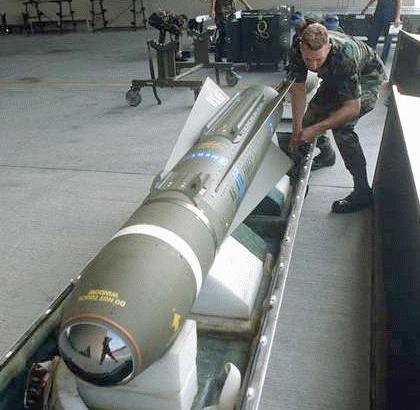 |
| Photo: USAF |
| AGM-65D |
When the AGM-65C was cancelled, development of a "Laser Maverick" for the USMC switched to the AGM-65E, whose WGU-9/B laser guidance section is cheaper than the AGM-65C's. The AGM-65E uses a heavy 136 kg (300 lb) WDU-24/B penetrating blast-fragmentation warhead, which is triggered by a FMU-135/B delayed impact fuze. It also features a reduced-smoke rocket motor in a WPU-8/B propulsion section, and entered USMC service in 1985. The CATM-65E is a captive-carry training version of the AGM-65E.
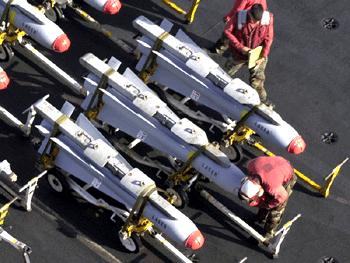 |
| Photo: U.S. Navy |
| AGM-65E |
The U.S. Navy's "IIR Maverick" is designated AGM-65F. It uses the IIR seeker of the AGM-65D in combination with the warhead and propulsion sections of the AGM-65E. It also features a SAD (Safing/Arming Device) for safer shipboard use. The AGM-65F has also a slightly different seeker software for optimum performance against surface ships. The CATM-65F captive-carry training version replaces the WGU-10/B guidance section with a WGU-13/B.
The AGM-65G is an improved "IIR Maverick" for the USAF. It is based on the AGM-65D, but uses the heavy warhead and fuze of the AGM-65E/F because it is especially designed for use against hardened tactical targets. The AGM-65G also has a new digital autopilot and improved tracking and target selection options. The new autopilot allows the operator to select a lower trajectory to prevent break of lock in clouds. The AGM-65G entered operational service with the USAF in 1989. The AGM-65G-2 is a -65G with the guidance software replaced by a modified version of the AGM-65F's software. Like the AGM-65D-2, the G-2 also has a faster seeker for higher accuracy and moving target tracking.
 |
| Photo: USAF |
| AGM-65G |
Training variants of the USAF's AGM-65 missiles do not use ATM-65 designations as one would expect. Instead the training Mavericks are known semi-officially as TGM-65 (TGM = "Training Guided Missile"), with variants being designated TGM-65A, TGM-65B, TGM-65D and TGM-65F. Captive-carry (non-launching) training missiles ("CATM-65") received the designation A/A37A-T9 by the USAF, and dummy (non-flying) missiles ("DATM-65") for ground handling training are designated A/E37A-T60. The latter are also used by the Navy, which sometimes calls them DATM-65E/F.
The Maverick was extensively used by the USAF in Operation Desert Storm (ODS). More than 5000 missiles of the AGM-65B/D/G variants were launched, mainly by A-10A aircraft. The hit rate was reported as between 80% and 90%. The USMC also fired a few AGM-65Es in ODS, with a reported hit rate of about 60%.
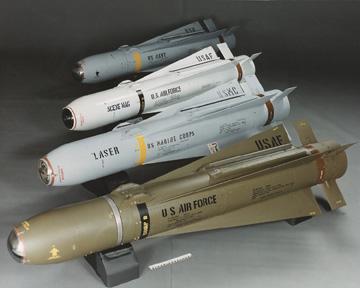 |
| Photo: Raytheon |
| From front: AGM-65D, AGM-65E, AGM-65B, AGM-65F |
The IIR seeker of the AGM-65D had some problems during Operation Desert Storm, because of thermal clutter in the excessive heat of the desert. Therefore, the USAF decided to field a Maverick with a modern TV-guidance section using a new CCD seeker. Raytheon developed a CCD seeker to replace the TV or IIR seekers of some existing AGM-65 missiles. The new CCD seeker gives remanufactured missiles higher reliability, higher lock-on range and better low-light performance. However, the CCD seeker is not suitable for night-time use.
The designation AGM-65H was assigned to AGM-65B/D missiles upgraded with the new CCD seeker. It was originally planned to convert many old AGM-65Bs and -65Ds to AGM-65H standard, but these plans were apparently cancelled in favour of the AGM-65K. The AGM-65J designation applied to U.S. Navy AGM-65F missiles rebuilt with the CCD seeker. As such it would have been very similar to the USAF's AGM-65K. The AGM-65J was initially planned to enter service in December 2001, but this appears to have been cancelled, since the Navy doesn't mention the AGM-65J in its inventory. The AGM-65K is an AGM-65G upgraded with the CCD seeker. At least 1200, but possibly up to 2500, AGM-65G rounds were planned for conversion to AGM-65K standard. The CATM-65H and CATM-65K are the captive-carry training versions of the AGM-65H/K.
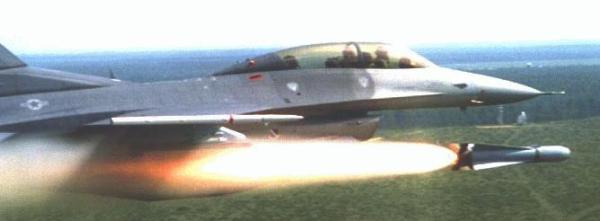 |
| Photo: DOD |
| AGM-65 (exact model unknown) |
In the mid-to-late 1990s, Raytheon proposed a Maverick development called "Longhorn". This was to feature many significant improvements, including a data link (for optional lock-on after launch), additional turbojet sustainer propulsion (for increased range of up to 75 km (46 miles)), GPS/INS in-flight navigation, and mm-wave radar or IIR terminal seeker. However, the "Longhorn" was not developed.
The final Maverick version is the AGM-65L. The AGM-65L is an improved AGM-65E with a new laser seeker for use against small fast-moving targets, which was developed in the 2011/2012 time frame. AGM-65L missiles were produced by upgrading existing older Maverick rounds, and both the USAF and USN ordered several hundred AGM-65L conversions. The CATM-65L is the captive-carry training variant of the AGM-65L.
Production of new-built AGM-65 missiles ended around 1999 after more than 75000 missiles (including production for foreign customers) had been built. The main U.S. platforms for the AGM-65 are currently the A-10, F-15E, F-16 and F/A-18 aircraft. The Maverick is fired either from single-rail LAU-117/A or triple-rail LAU-88/A launchers.
Specifications
Note: Data given by several sources show slight variations. Figures given below may therefore be inaccurate!
Data for AGM-65A/B/D/E/F/G:
| AGM-65A/B | AGM-65D | AGM-65E | AGM-65F/G | |
|---|---|---|---|---|
| Length | 2.49 m (98 in) | |||
| Wingspan | 71.9 cm (28.3 in) | |||
| Diameter | 30.5 cm (12 in) | |||
| Weight | 209 kg (462 lb) | 220 kg (485 lb) | 285 kg (630 lb) | 304 kg (670 lb) |
| Speed | supersonic | |||
| Range | > 27 km (17 miles) | |||
| Propulsion | Thiokol SR109-TC-1 solid-fuel rocket | Thiokol SR114-TC-1 (or Aerojet SR115-AJ-1) solid-fuel rocket | ||
| Warhead | 57 kg (125 lb) WDU-20/B shaped-charge | 136 kg (300 lb) WDU-24/B penetrating blast-fragmentation | ||
Main Sources
[1] Norman Friedman: "World Naval Weapons Systems, 1997/98", Naval Institute Press, 1997
[2] Bill Gunston: "The Illustrated Encyclopedia of Rockets and Missiles", Salamander Books Ltd, 1979
[3] Christopher Chant: "World Encyclopaedia of Modern Air Weapons", Patrick Stephens Ltd., 1988
[4] Hajime Ozu: "Missile 2000 - Reference Guide to World Missile Systems", Shinkigensha, 2000
[5] Bernard Blake (ed.): "Jane's Weapon Systems 1987-88", Jane's, 1988
[6] Airforce Technology Website: AGM-65 Maverick
Tactical Air-Ground Missile
[7] U.S. Air Force: AGM-65 Maverick Fact Sheet
[8] U.S. Navy: AGM-65
Maverick Guided Missile
Back to Current Designations Of U.S. Unmanned Military Aerospace Vehicles
Back to Directory of U.S. Military Rockets and Missiles
Last Updated: 15 December 2024